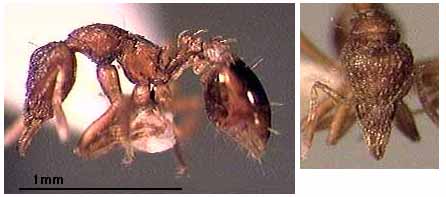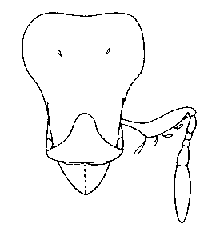

| return to guide introduction | go to genus list |
ACANTHOGNATHUS
|
 |
Uniform habitus; 11-segmented antennae. Wet forest leaf litter; uncommon.
GLAMYROMYRMEX

Uniform habitus; shield-like face; downward-curving mandibles; 6-segmented antennae; deep antennal scropes with eye situated below scrobe. Cryptic inhabitants of forest leaf litter; rare.
NEOSTRUMA

Uniform habitus; 6-segmented antennae; mandibles evenly tapering to small apical fork; variable number of small denticles preceding apical fork; labrum long, and on dry specimens usually projecting downward (arrow). Cryptic ants in forest leaf litter; common but infrequently collected.
SMITHISTRUMA

Variable habitus; 6-segmented antennae; antennal scrobes present, with eyes situated below scrobes; head and mandibles elongate (but without apical fork as in Strumigenys). Cryptic ants of forest leaf litter; moderately common.
STRUMIGENYS
|
 |
Moderately diverse habitus; 6-segmented antennae; antennal scrobes present, with eyes situated below scrobes; mandibles elongate with apical fork, but of highly variable length, shape, and dentition (constrast with the more uniform Neostruma). Cryptic ants of forest leaf litter; common.
TRICHOSCAPA

One species possibly in Costa Rica (T. membranifera); 6-segmented antennae; antennal scrobe with eye situated below scrobe; mandibles triangular with distinct gap between basal margin of mandible and anterior margin of clypeus. Pantropical tramp in disturbed areas; presence in Costa Rica not verified by Longino.
Page author:
John T. Longino, The Evergreen State College, Olympia WA 98505 USA. longinoj@evergreen.edu